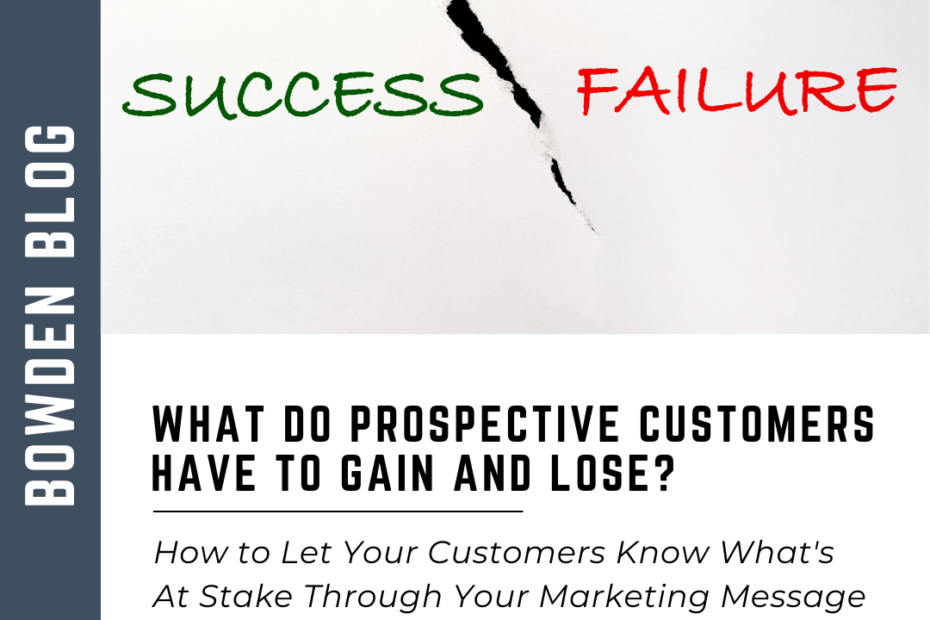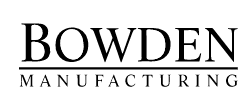Part 4 of 4
Marketing Your Manufacturing Business: Giving Your Customers a Clear Picture of Success vs Failure
Do Your Prospective Customers Know What’s at Stake? Help them see what can be won or lost if they do or do not work with your company.
You could be missing out on new sales if your website and emails don’t help Customers picture the Happy Ending to their Story after you help them solve their Problem.
If we were to look at your Company website and ask the question, “How will my life be better if I use this product or service to solve my Problem?” would the answer be obvious? Most likely not. Without painting a clear picture of the future, potential Customers won’t move forward. People will head toward a vision of what their life can look like, so you need to help them see it.
Last week, we continued our four-part series on applying Donald Miller’s book, Building a StoryBrand, to Manufacturing companies. Using the StoryBrand framework, our Team at Bowden has overhauled the way we speak about our company and how we reach out to the marketplace. Hopefully, this series will help you skip some of the mistakes we made along the way.
If you’ve completed the Action Steps from the first three weeks, you’ve done the following:
This week is the final installment of the series, and you’ll take the remaining action steps as the Guide, to help your Hero (the Customer) on their journey toward a successful outcome in solving their Problem.
Success or Failure
What’s at stake for your prospective Customer as they decide how to solve their Problem? Will they take the path towards a successful outcome, or not? Clearly describing the possible results of their choice, both good and bad, will help them select their new future.
By this point, you’ve established your Company as the Guide, you’ve given the Hero the Plan needed to solve the Problem and you’ve called the Hero to Action. The final step is to make sure the Hero knows clearly what’s at stake as they contemplate their actions. Identifying what can be won or lost adds urgency and interest to their Story.
A Vision of Success
The first side of the Stakes is the positive side. What good will happen if they decide to use you and your company to solve their Problem? There certainly are plenty of positive outcomes that they’ll likely achieve and you need to articulate them as clearly as possible.
A good starting place is beginning with the resolution of the Problems your Customer is looking to solve. If there is a way to describe how the External Problem, the Internal Problem and the Philosophical Problem are all resolved in one shot, your Customers will experience a sense of pleasure. Go back to your descriptions of each of those Problems from the earlier steps and write out how they are resolved in the end.
Here are a few tips on describing Success on your website and in your copy:
- Make it visual, if possible – Paint a picture as specifically as possible so they can picture it clearly
- Include emotions – How will they feel when their problem is solved?
- Use details – Don’t be vague, they need to know exactly what to expect.
- Have photos of smiling, happy people enjoying your product – Customers will identify with them and want to become like them
People want to be taken somewhere. Help them imagine what arriving in that new successful spot will be like.
Here’s an example of what we used to describe Success, directly from our website:
- Control the Process, Lose the Stress
- Make your designs a reality and optimize your desired outcomes for manufacturing.
- Gain the capacity to fulfill your routine orders, with options for emergencies.
- Be equipped to respond to the changing conditions and demands of your customers.
- What if you could get all the benefits of having an in-house manufacturing shop, but without the cost, hassle, and management nightmare? With Bowden Manufacturing, you get the capacity, the engineering horsepower, and transparency you need. When you talk to us, it’s like talking to your own shop foreman. Our goal is to give you control over the process but without the burden that comes with having to do it on your own.
Action Step 12 – Write Out What Success Looks Like for Your Customer
- Make the copy visual, emotional and detailed.
- Include photos of smiley, happy people using your products.
The Picture of Failure
The opposite side of the Stakes is the negative side. If there’s nothing at stake, the story isn’t going to be compelling. Every human being is trying to do two things: achieve something good and avoid something bad. They are the two dominant modes that drive us to action.
One thing to keep in mind, humans are more motivated to avoid a loss than to achieve a gain. If you can describe what they might lose if they don’t take the right action (i.e. engage with you to solve their problem!), they will work hard to avoid that situation.
Here are a few tips on describing Failure:
- Make it visual, if possible – Paint a picture as specifically as possible so they can picture it clearly
- Include emotions – How will they feel if their problem isn’t solved or continues to get worse?
- Use details – Don’t be vague, they need to know exactly what to expect if they go down that incorrect path
It’s the stakes that drive people to action and your Customers will want to avoid failure and negative consequences. The more compelling the image, the more likely they will be to take action to prevent a loss.
Here’s an example of what we used to describe Failure, directly from our website:
- Frustrated by Your Supply Chain?
- …without the cost, hassle and management nightmare?
- Wonder if your Vendors really care about your business?
- Begging for Status Updates?
- Searching for Straight Answers?
- Too many Vendors keep their customers in the dark.
Action Step 13 – Write Out What Failure Looks Like for Your Customer
- Make the copy visual, emotional and detailed.
- Creating a clear picture of the negative consequences will drive them to take action.
Who Are You Helping Your Customers Become?
All stories are really about transformation.
The Hero of a story starts out a mess. They are weak, afraid, unsure, doubting themselves, ill equipped and unskilled. You think of Heroes as strong characters, but they actually start out very weak. They start out weak as throughout the story, with the help of the Guide, they become strong. In the challenge of the Problem they are facing, they begin to grow and by the end of the story, they’ve transformed into the strong Hero that you typically think of when you consider that story.
Inviting your Customer into a story where they have a Problem is the opportunity that you can help them transform by helping them solve their Problem and at the end, they feel strong, well equipped, skilled, brave and sure of themself.
The reason these stories are so compelling is that we, as human beings, have a deep desire to be transformed. We identify with these stories because they tap into a core hope inside of us. As you help facilitate your Customers’ transformation, you will help make them and the world a better place. Reaching the climax of the story, as they have overcome the challenges and solved their Problem, they will recognize that they have changed….they are different and you have helped them attain a new identity…..their Aspirational Identity. They have become a better version of themselves.
The opportunity to create this transformation in your Customers actually increases the value of your product or service. If you can describe the change they can experience by using your product or service to solve their Problem, they will be more attracted to you and your brand.
Here are some questions to help identify the Transformation of your Customer:
- How was your Customer feeling about themselves before they used your product or service?
- Who will your Customer become after they use your product or service? What is their Aspirational Identity?
- What sort of person do you want to help your Customers become? What Aspirational Identity can you offer them?
Here’s an example of what we used to describe the Transformation of our Customer, directly from our website:
The status quo will never fix itself. If you stick with vendors who leave you in the dark, miss deadlines, and make promises they can’t keep – then you’ll be forced to do the same. You won’t have the information your customers are looking for, you’ll go past your deadlines, and you’ll let your customers down. Instead, stay in control of your project without having to do the heavy lifting. When you partner with Bowden, you’ll have full visibility of your project progress, regular updates you can count on, and a Team who shares your high standards.
Action Step 14 – Write Out the Transformation That Your Customer Can Experience by Using Your Product or Service & Write Out their Transformational Identity
- Start with how your Customer feels about themself with their Problem, before you became their Guide to help them use your product or service to solve it.
- Then describe who they can become after they use your product or service. Write out their Aspirational Identity.
Now Put it All Together – The StoryBrand Brandscript
Take this time to complete the Action Steps 12-14, to finish your StoryBrand Brandscript and have the copy you need to invite your Customers to be the Hero of the Story and you be their Guide.
Next week, we’ll share some of our results and the Before & After story of implementing the StoryBrand framework into a Marketing Program. We’ll also talk about hosting a live workshop on Zoom on June 2nd to help folks who are trying to Market their Manufacturing companies. It’s clear from the response to this blog series that we’re not the only ones who have been trying to figure it out!
Join Us for a Marketing for Manufacturing Live Workshop!
June 2nd | 3-4:30pm EST | Zoom
Over the past four weeks, our blog has covered the 14 Action Steps that goes into creating your own Storybrand marketing message. We’ve provided lessons from our own journey, tangible actions to take, and plenty of examples to get you started. Based on the response we’ve gotten from many of our readers, we decided we should put on a Workshop to engage with folks that are struggling to apply the StoryBrand framework. We started our StoryBrand journey on our own but then hired a StoryBrand Certified Guide to help us put it into practice more efficiently. He’ll join us for the workshop to help make sure it’s a productive session. In this 90-minute workshop, we will cover the implementation of the StoryBrand framework for Manufacturers. We’ll help you along the journey by answering your questions and providing additional examples. Once you sign up, you’ll have the opportunity to take a free StoryBrand Assessment to help see where your greatest Marketing need might be so you can maximize your results from the workshop and beyond!
Reserve Your Spot!

